 We spent our last day in South Africa in gaol 12 kilometres from Cape Town...
We spent our last day in South Africa in gaol 12 kilometres from Cape Town...For nearly 400 years, Robben Island was a place of banishment, exile, isolation and imprisonment for criminals, social outcasts, activists and the unwanted.
During the apartheid years, Robben Island's reputation for its institutional brutality was widely recognised. Numerous freedom fighters including Robben Island's most famous resident, Nelson Mandela, were forced to serve out long sentences in the most basic of conditions or their beliefs (see a picture of the high security cell in section B which Mandela called home for 18 years). Many of the political prisoners, initially incarcerated alongside common criminals and then later moved to the maximum security prison while the criminals stayed in a medium security prison, were subjected to hard manual labour in an attempt to suppress opposition to apartheid by crushing their morale.
Eugene (pictured below), our informative and charismatic guide, was arrested at 16 for organising a student demonstration against apartheid policies in the 1980s and spent 10 years as a political prisoner on Robben Island. He told us how apartheid's regulations even extended to life in prison, as "coloured" prisoners were given better food, clothing and working conditions than those prisoners classified as "bantu" (black), until the ICRC intervened sometime in the 1980s. The ridiculous methods for determining whether someone was coloured or bantu included an examination of the shape of their shoulders and the "pencil test" where classification was determined based on whether or not a pencil placed in a person's hair fell out when they shook their head.


0 Comments:
Post a Comment
<< Home